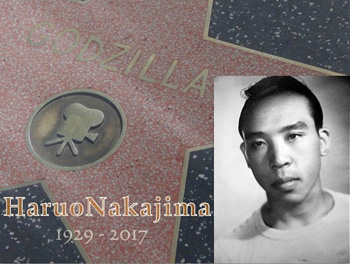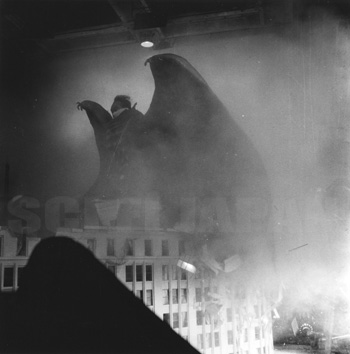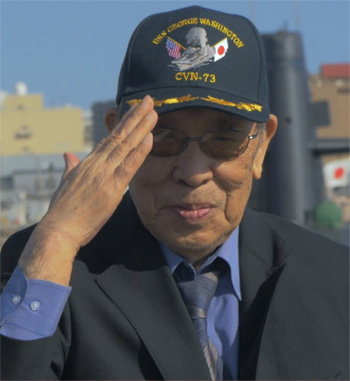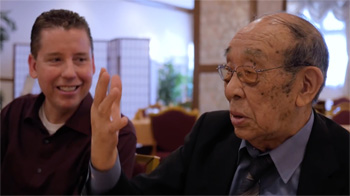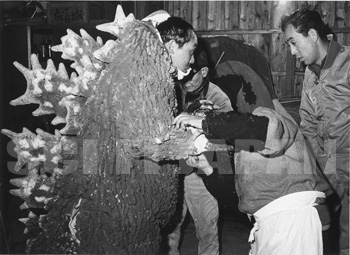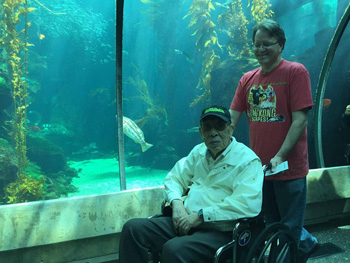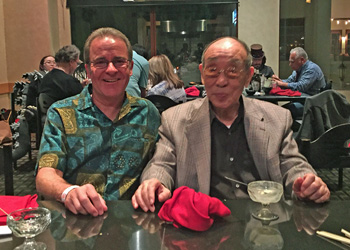On August 7, 2017, the news came out that Haruo Nakajima, beloved Godzilla and Kaiju suit actor and a pioneer of the art, had passed away. Word spread through fandom quickly via social media and the outpouring a affection, grief and shock was amazing and heartfelt. At SciFi Japan, we felt a fitting tribute needed to be done and it was something that should not be rushed or thrown together. Over the last month we have been talking to people who worked closely with Mr. Nakajima to bring him to the US and around the world, to meet his fans and share his stories of the golden years of suit acting in Japanese films. We start off with an overview of his life and career, written by author Ed Godziszewski, followed by remembrances from a variety of colleagues that traveled with him over the last few years. Author Ed Godziszewski, publisher Japanese Giants and co-author of Ishiro Honda: A Life in Film From Godzilla to Kurosawa. Haruo Nakajima was born in Sakata City, Yamagata Prefecture, on January 1, 1929. As the son of a butcher, in his youth he often had to carry heavy slabs of meat while working in his father’s shop and he labored hard to take care of the business’ animals. With all these tasks and a steady diet of meat, he felt that he was able to develop a strength and stamina in his formative years that would serve him well in his future endeavors. His father was quite strict, so he also developed a keen sense of discipline at an early age. Growing up in the time of Japan’s escalating imperial ambitions, elementary school was looked upon as a time of training for a future military career. While in elementary school, he trained in kendo and judo, and he joined the Kaiyo Shonen-den (Marine Boys Troop), a Boy Scout-type group that taught kids to swim, how to handle boats, and even how to give flag signals—all with an eye on eventually joining the Navy. Military indoctrination made it so that every young boy’s ambition was to become a soldier. By the time he was old enough to get formal military training, Japan was not only embroiled in expansionist aggression in mainland China, the Pacific War was also in full gear. His destiny as a cog in the Japanese war machine was predetermined, a destiny that most kids eagerly embraced in those days. When he was 13 years old, his father died of a stroke. With his older brother taking over the family business, he decided to move away from Yamagata and decided to join the Navy, a decision made easier because he had not passed his high school entrance exam.
With a deep love of airplanes, at the age of 14, he entered the Imperial Japanese Navy and enrolled in an academy (called yokaren) that trained reserve pilots. During gunnery training, he had a brush with death as his plane was hit by enemy fire, ripping a hole in the fuselage next to his seat. When Admiral Yamamoto, architect of the Pearl Harbor attack, was killed, as a member of the Imperial Navy, Nakajima participated in the lavish funeral ceremony held in Tokyo Bay. He vividly recalled that over 400 ships assembled that day, including the mighty battleship Yamato. “The Yamato was an incredible sight…it extended up 50-60 meters from the waterline, the same height as Godzilla!” Nakajima was stationed on the Shinano, a Yamato-class battleship that had been converted to an aircraft carrier. During his brief assignment on the Shinano, he would see small suicide boats called shinyo (i.e. shaking ocean) making practice runs—boats manned by his fellow classmates from the yokaren, a memory that haunted him for years to come. Although Shinano was sunk on its maiden voyage, Nakajima escaped death by being transferred to a communications ship just prior to Shinano setting sail. The war ended when he was 16 years old, just before he was to be sent into combat. Life in post-war Japan was difficult for everyone as unemployment was rampant and both food and necessities were scarce. However, Nakajima was fortunate enough to get a reference from one of his yokaren comrades and obtained a relatively high-paying job as a truck driver on a US military base in Yokohama. After a year he lost his job over a speeding violation, and with nothing else to do, on a whim he answered a want ad for the International Motion Picture Acting School. Acting school was a one-year program run by two actors on loan from Toho Studios, and students often got acting jobs from the major studios as part of their training. Nakajima’s first acting job was for Akira Kurosawa on STRAY DOG, playing the part of a drunken bar patron that gets into a brawl. Unfortunately, his scene was cut from the film, so his screen debut had to wait until he officially entered Toho in 1950 as a contract actor. Among his classmates were Shoichi Hirose, who would later play Godzilla opponents King Kong and King Ghidorah, and Tetsuro Tanba, who joined Shin Toho after graduation and later went on to become a big star at Toho.
As a member of Toho, Nakajima appeared almost exclusively in period dramas, performing small roles in action sequences such as swordfighting and riding horses, usually in full armor (which in those days was the real thing, not plastic as would later become the norm). Much of his early work was done for Hiroshi Inagaki, including an appearance in the SAMURAI TRILOGY. Whatever the job, strenuous or dangerous, Nakajima matter-of-factly accepted and did his best. Working as a stunt and action actor also had its practical considerations—such kind of special work also merited extra pay. It was his intention to be versatile, able to do anything, which would increase the kind of jobs that he could obtain. As a result, during the making of Ishiro Honda’s war epic EAGLE OF THE PACIFIC (1953), Nakajima was given the job of playing a fighter pilot whose plane caught fire, and he in turn catches fire while escaping from his cockpit. This unique action caught the eye of the director. The year 1954 was an auspicious one. Nakajima appeared in two of the most famous and successful Japanese films in cinema history. First, he had a small role as one of the bandits in Kurosawa’s epic SEVEN SAMURAI. “It was the scene where the master swordsman Kyuzo, played by Seiji Miyaguchi, Mifune, and the young boy set an ambush on the three bandits in a field of flowers. Mr Miyaguchi flashed his sword and one of the bandits was killed… that was me!” But the film which would determine his life’s path would come next…Ishiro Honda’s GODZILLA. He was selected to play the title character. Nakajima was never told why he was chosen to play the monster in Honda’s film. Perhaps the director had taken note of him while making EAGLE OF THE PACIFIC, maybe it was his reputation as being willing to take on any difficult role without complaint. Whatever the reason, Nakajima gladly accepted, thinking he would merely be putting on some sort of animal costume, much like in a stage play, along the lines of a pantomime horse. Nothing could have prepared him for the reality of the task. Consulting with special effects director Eiji Tsuburaya, Nakajima was told that this would be a gigantic dinosaur-like creature, so there was no clear reference for him to study. He was instead advised to study the movements of large animals such as bears and elephants. When the fateful date came in early June of 1954, he got his first glimpse of Godzilla. Far from a simple cloth suit, this was a 100kg+ concoction of fabric and cushions shaped onto a framework of wire and bamboo and covered with a primitive kind of latex. It was so stiff that the suit could practically stand on its own without anyone inside. Nakajima was to share the duties of portraying Godzilla with Katsumi Tezuka, a Toho veteran who was 17 years his senior. Nakajima was able to manage to walk 10 meters in this prototype, whereas Tezuka could barely manage a couple steps. While the image of Godzilla proved satisfactory to the staff, this dry run pointed up the main problem facing the crew. This kind of special effects technique was without precedent—to make it work, everything was going to be trial-and-error. While the staff labored to figure out how to build a more flexible suit and how to film it, the performance was left largely up to Nakajima to improvise.
A second Godzilla suit was made with emphasis on reducing the weight and increasing flexibility, but nevertheless it still posed a formidable challenge in which to move and act. As Nakajima would tell it, Tezuka only performed one scene as Godzilla approached the Diet Building, but he fell and badly injured himself, and as a result all of the Godzilla scenes that made it to the final film featured his performance. The physical toll of wearing the suit was considerable. Typically, he could last around 10 minutes inside the suit at a time—his ability to see and breathe courtesy of a few small holes located in the monster’s neck (the suit’s head sat atop his own head). Easily a cup of sweat would be drained after a stint inside the suit, and he would lose as much a 5kg during a shoot, requiring that liquids and salt water be kept in ready supply to replenish his fluids. Nakajima estimated that he could perform as little as 10% of his intended actions through the stiff outer suit. But he persevered, never complaining, and when the job was done, Nakajima was an integral part of creating what would become a worldwide phenomenon, and in the process he personally came to pioneer the field of suitmation. Although he returned to acting in period dramas after Godzilla, as Nakajima anticipated, Eiji Tsuburaya called upon him to do more suit acting. Since Godzilla was such a huge financial success, Toho looked to science fiction as a money-making genre. Year by year, the jobs continued to roll in for him as he would assume the roles of various monsters in GODZILLA RAIDS AGAIN, RODAN, VARAN, etc. Tsuburaya came to rely on Nakajima almost entirely to create and choreograph monster action, and he eventually became alternately a coach and mentor for other suit actors as well. When Eiji Tsuburaya started creating monster and science fiction shows for television under the newly formed Tsuburaya Productions, he turned to Nakajima to come to his company to help out, both as an actor and as a teacher for the novice actors in this fledgling company. Tsuburaya’s reliance on Nakajima was illustrated by the somewhat apocryphal story that Nakajima had received an offer to come and work in Hollywood. Tsuburaya was shocked, saying “without you, we can never make Godzilla movies!” With monster films taking up only 3-6 months of his time, Nakajima continued to work as an action actor outside the genre, appearing in bit roles in many productions, including Kurosawa’s HIDDEN FORTRESS and YOJIMBO, war epics like I BOMBED PEARL HARBOR, and period pieces such as DAREDEVIL IN THE CASTLE. While making SF films, when he had some spare time, it was not unusual for director Honda to come to the SFX stage and borrow Nakajima for bit parts, allowing him the chance to have his face seen on screen. Despite being the ‘star’ of his films, the public hardly knew what he looked like outside of cameos and bit roles.
Just as monsters on TV started to proliferate, the Japanese film industry started to fall on hard times. Especially with monsters available for free on on TV every week, the box office suffered a sharp decline. But the major blow to the production of monster films came in January of 1970 when Eiji Tsuburaya suddenly passed away. With his long-time director gone and the studio constantly cutting budgets and staff, slowly Nakajima started to lose the resolve to keep acting. By the time he wrapped filming on GODZILLA VS. GIGAN, his 12th outing as the King of the Monsters, he knew the end had arrived. Nakajima had come to realize that at his age, now 43 years old, he was reaching the physical limits of his ability to keep going as a suit actor. He and many other contracted employees were let go from Toho--Nakajima suddenly found himself unemployed. Eventually Nakajima found work at a bowling alley affiliated with the Hankyu company of which Toho was a part. Although he had left the movie industry, on occasion there would be the odd call for an interview. When Godzilla made a comeback in 1984, he even appeared on the TV special “THE GODZILLA SHOW” in a special segment along the lines of “WHAT`S MY LINE?” where a panel asked questions to determine which of three people was actually the man who played Godzilla (one of the ‘imposters’ appearing with him was suit maker Noboyuki Yasamaru). But by and large, Nakajima had settled into a mostly anonymous retirement. In the early 90s, Nakajima suddenly inched back into the spotlight. In the midst of Godzilla’s resurgence with the “vs Series” led by SFX director Koichi Kawakita, an occasional request for interviews would come his way. In particular, fans from overseas began to seek out Nakajima—the first of them being David Milner who published an interview with him in Cult Movies. This would eventually lead to what would be the first of many invitations to appear at conventions in the West—in this particular case, it was G-Fest 96 in Chicago. Nakajima was genuinely gratified by the outpouring of support and appreciation for his film work, and for the last 20 years of his life, he relished the chance to travel and meet his fans, regaling them with stories of his career. His notoriety in Japan also increased, and he eventually participated in several documentary works on Japanese SF and in particular about Godzilla, both in Japan and overseas. The fame which had eluded him for most of his life finally came his way. He passed away on August 7, 2017 from pneumonia at 88 years of age, survived by his daughter Sonoe. ******* Haruo Nakajima--Why He Was Special? Suit actors, both in the West and in Japan, have come and gone, but Haruo Nakajima clearly stands out above them. What was it that made him stand apart from the rest? It was no small accomplishment that Nakajima was a true pioneer in his field. When he took the job in 1954 at the request of Eiji Tsuburaya, even the special effects master was uncertain how to accomplish the task. Nakajima took it upon himself to study the movements of large creatures and adapt them to his performance. But in addition, he also gave consideration to how the camera would capture his performance, adjusting his movements and posture accordingly. When the camera was to be run at high speed (to slow a creature’s movements for creating the illusion of great height and mass), he recognized that he would also have to move much quicker than normal to create a realistic impression. If not, the resulting footage would look unnatural and lack the image of a living creature. Nakajima also took into consideration the unique characteristics of each suit. In the case of Godzilla and other upright monsters, suits were constructed so that the monster’s head sat atop his own head—his head was inside the monster’s neck. This created an imbalanced body image, with shoulders and arms appearing too low compared to the head. Among suit actors in giant monster films, Nakajima was alone in recognizing that the actor needed to raise his arms up high, next to his own head, to balance the image of the monster. His technique is on vivid display in the suit actor segment of the 2008 documentary BRINGING GODZILLA DOWN TO SIZE. Demonstrating his Godzilla performance, he alone walks with his arms raised. It looks strange outside of the suit, but it creates the most natural image on screen. Compare the look of monsters from the 50s and 60s to those in subsequent years, and the difference becomes obvious.
While it was already remarkable that Nakajima was able to create an acting technique for suitmation, this also made him Tsuburaya’s invaluable asset on the set. Anyone who would come in to play opposite Nakajima was new to this job, so Nakajima would have to train them. But Tsuburaya developed such deep trust in Nakajima’s abilities that it was usually up to him to choreograph the action among the monsters. Sometimes the script would just simply describe the scene as ‘monster battle’—the details were often left up to Nakajima to create. Relying on his extensive judo training, Nakajima was able to plan sophisticated and exciting battle action that the director and writers would have difficulty imagining. The relationship between Nakajima and Tsuburaya became one of mutual trust, one of those unique situations where very few words were required between them. To Nakajima, the content of the scene was his job to create so that Tsuburaya could concentrate on how best to capture that action on film. Nearly everyone would ask Nakajima about how difficult and dangerous his suit acting job was, and indeed it was. He was asked to perform in suits weighing as much as 70-80kg, some of them incredibly inflexible, each with little to no ventilation and with but a few small holes through which to see and breathe. Sweating profusely inside these mobile sweat boxes, his stamina was challenged and the fabric lining would also wear away at his skin. Inside the studio, he performed under the glare of powerful studio lights, and outside on open sets he would endure the blistering heat of summer as well as winter’s freezing temperatures. Having had scuba training, he was also uniquely equipped to perform scenes where monsters would have to emerge from underwater. This was no small matter since the suits would absorb water like a sponge, nearly doubling in weight, making them enormously heavy. One false move and an actor risked drowning. There were even times where he was literally buried alive in the suit in order to perform a scene where he would emerge from underground. And in every film, he would have to deal with an assault of pyrotechnics and projectiles. But losing 5kg from the physical burden of playing a scene, having the suit catch fire, miniature missiles piercing the suit, being buried without any air, having an explosive burn through the suit—for him, these were no big deal, just a part of the job. He honestly never thought of the danger and hardship involved. He considered himself a professional, it was what he was hired to do and he was being paid to do it, so it was his policy to do it without complaint. Even if he was injured, his idea was that he should not speak up. “I want the director to think I am immortal!”, he said. He showed great pride in this attitude, that he should do whatever the director would ask—after all, they will not ask you to do the impossible. By being versatile and showing you can do anything, you gain the trust of the director, and you become invaluable to them.
Despite all the hardships and all the special value he contributed to the monster films, Nakajima labored in relative obscurity. For many years, Toho and Tsuburaya did their best to keep from the public that there was someone inside the suits, bringing them to life. But for Nakajima, this was no big deal at all. Once again he took the practical approach—that he was a professional actor, this is what he was being paid for, so why should this be an issue? In fact, from his viewpoint, this was a good thing. His performance was featured in all of his films—everyone could notice his work. And the fact that he was never recognized in public was just fine with him—he never thought of himself as a star. He enjoyed his privacy—he could live his life and go have some drinks just like any other normal guy. Like everyone, he did have his opinions about his films. He did not take exception to how he was asked to make his characters act. If the director asked him to play it serious or act comical, he took the job seriously and did his best. He completely trusted the director. But he did take great exception to the studio using stock footage, considering it an insult to the audience. In his later years he would also voice his displeasure over newer films and their move away from physical fighting and use of computer graphics. As the age of computer graphics seems to signal the death knell of suit acting, Haruo Nakajima’s passing serves to remind us of a time when special effects were truly special, created not by computers and programs but by individuals with passion, creativity, and the drive to do their best, even under harsh conditions. While they may look more sophisticated or even more ‘real’, computer-driven special effects also mark the end to an era where the audience could be able to be entertained by the fascinating personal stories of people like Haruo Nakajima who created literally created film memories from blood, sweat, and tears. Farewell to the father of suit acting.
Ed Holland, editor/founder of Monster Attack Team magazine. Twenty-one years ago I met and briefly interviewed Godzilla suit actors Haruo Nakajima and Kenpachiro Satsuma at G-Con 1996 and remained a loyal fan as Joe Riley (1964-2007), David May, Mike Keller, and I sporadically put out issues of our tokusatsu culture magazine Monster Attack Team (MAT) starting as a fanzine/fanclub/cable access program in Dallas, Texas. I caught up with Nakajima-san in later years during his North America appearances leading to a MAT and Legendary Pictures sponsored Armed Forces Day GODZILLA 2014 theater screening at Commander Fleet Activities Yokosuka, Japan. Mr. Nakajima trained here during World War II and worked off base after the war, consequently in a section of town, where I taught English conversation lessons. At our 2014 event five-hundred and fifty American and Japanese fans attended, where Nakajima was respected for his service in the film and television industry as an actor, and for his military service to Japan, during a challenging period in the nation’s history. Despite the odds then and in later life Haruo Nakajima did it all with zeal and vigor to the very end and was passionate towards family, friends, and his loving fans around the world. Twenty plus years after our first meeting it brought it all back into perspective during a wild Godzilla party at Alien Con in October 2016. I was beckoned by Nakajima-san to make suit actor Tsutomu Kitagawa report to him for some martial arts training in front of other fans and it was an amazing way to cap off a wonderful time at a convention with the highlight being three Godzilla suit actors from three generations. Ask the Kaiju Brotherhood group about the Grillin’ with Godzilla event, they will tell you all about it. Definitely a night to remember in northern California.
Meeting and actually hanging out with Mr. Nakajima three times in Japan and the US last year is something I will always cherish. We all admire the films and programs that he was a part of since before some of us could even tie our shoes, and being able to bond with someone who lived, and breathed life into characters larger than life, still charges me up. His work led to the original golden kaiju boom and his craft plus the talents of Ishiro Honda, Eiji Tsuburaya and others can never be duplicated by any movie making technology. It is just not possible to recapture that brand of magic, and generations will continue to talk about his work long after we are all gone. Haruo Nakajima was and will always be the real deal. I am very thankful to have been involved in articles, interviews, related books, television programs, podcasts, charity functions, and events squarely focused on Nakajima-san, a person destined to accomplish things, no one else could or ever have done. He did it all with fury and grace and was a devoted husband, father, and friend. Words cannot express the sadness we are feeling, and the joy that he is relishing in from our remembrances of him, duly noted around the world. Long Live Haruo Nakajima, the God of Suits and biggest movie and TV star of all time!
Jonathon Lee, representative Celebrity Icons. All my life I had been a Godzilla fan, from watching the movies, to pretending to be Godzilla at recess, I have followed my favorite giant monster everywhere, and the love never faded. In 2011 I had the pleasure of meeting Haruo Nakajima at MONSTERPALOOZA in Burbank, California. Being such a big fan I was excited to meet my childhood hero and I wondered what kind of man he would be. I was nervous, but all my fears were lifted when we met. One of the fondest memories of my life was meeting Mr. Nakajima for the first time. When I went to shake his hand, he not only took my hand but he pulled me down to put his arm around me in full appreciation. Although we had a language barrier, I could feel genuine appreciation for his fans. It was a life changing moment for me, as from that day on I would travel to many conventions around the USA to see him, I would surprisingly I become a member of the staff that brought him out to these conventions. I will always remember how he was always gracious, loving, and humble when meeting his fans. The way the fan interactions would light up his life would always be a joy for all of us on staff to see. I believe all of us on staff relive the first time moments of meeting Nakajima when we see fans come to see him. Nakajima was a role model that never disappointed his fans, he endured long travels from Japan and gave his all every show, and it was incredibly encouraging to see. He always demonstrated was truly appreciative of those who were passionate about his work. Knowing Nakajima has changed my life personally, as traveling and working with him was an adventure that grew me as a person, eventually to a point where I felt confident to travel to Japan on my own this year, and meet him one last time. I can say I couldn’t have been on a better adventure, with better company. Mr. Nakajima, I’m so thankful to have known you and your daughter Sonoe and both of you will always be in my thoughts!
Steve Ryfle, co-author of Ishiro Honda: A Life in Film From Godzilla to Kurosawa. Like all of you, I’ve been thinking this past week about Haruo Nakajima and what his life and work has meant to me. And it occurred to me that this man, though he never truly received recognition for it, was a very good actor, uniquely so. When he was interviewed over the years, the same anecdotes would be repeated and emphasized over and over again: the heaviness and immobility of the original Godzilla suit; the dangerous accidents that could have killed him; the horrible working conditions such as blazing hot lights or freezing cold water; the fact that Tsuburaya and Honda “left it all up to me,” and so he observed the movements of zoo animals for inspiration; and so on. Discussed far less often is that Nakajima’s performances inside those monster suits had pathos and anger, feeling and emotion, sympathy and humanity. Nakajima’s monsters had range and complexity—even though he had no lines, he was able to respond to the demands of each particular story, and therefore each performance was different; he never just “phoned it in.” Think of the slow, brooding menage of the original Godzilla; the tragic fury of the original Rodan; the comic Godzilla that tussled with King Kong; the physical aggression of Baragon in FRANKENSTEIN CONQUERS THE WORLD; the menace of Gailah, the green gargantua; the heroic Godzilla of DESTROY ALL MONSTERS and GODZILLA VS. HEDORAH; the lovelorn ape in KING KONG ESCAPES; and so on. Though his face was hidden inside a suit or behind a mask, he mastered the art of using movement - or lack thereof - to bring these creatures to life and connect with the audience.
Dell Martinez, representative Celebrity Icons On Monday, August 7th, 2017, through the darkness of my slumber, I heard a faint ding, followed by several more dings. It was a sound I had heard thousands of times before, the unmistakable ding of Facebook Messenger. I fumbled in the dark for my phone and squinted as the bright light of the display hit my eyes. The time was 5:53 AM and it was Jim messaging me. As I read his message my heart sank and began to grow heavier as I read each successive word. “Terrible news. Nakajima-san passed away earlier today.” I put my phone down and just lay there staring up at the ceiling as an immense sadness enveloped me. Nakajima-san was Haruo Nakajima, and for three years my brother Jonathan and I flew all across the country attending various conventions, to assist him and other Japanese celebrity guests as handlers. Nakajima-san had a personality that was larger than life, quite fitting for the world’s biggest movie star. Haruo Nakajima was the original Godzilla. He donned the suit from 1954 to 1972, his performance in those films made Godzilla into the world renowned pop culture icon it has been for over 60 years. As big as Godzilla is in the world of sci-fi entertainment, Nakajima-san never made anyone feel small. In the hundreds of fan interactions I witnessed over the years, Nakajima-san always made sure his fans walked away wholly satisfied from their encounter with Godzilla. Fan reactions varied upon meeting him, most just humbly waited, while expressing their love for his work as he signed, wrapping things up with a quick candid photo with him at the table. Some fans were genuinely awestruck, standing there in near disbelief, delight, and amazement still on their faces as they walked away. In some rare instances, there were fans truly moved to tears at finally meeting an icon that was such a big part of their childhood. What I noticed as well was the wide variety of ages, nationalities, and walks of life among his fans. He took particular delight in meeting the young fans, his face lighting up as children came to meet the legendary Godzilla. Through it all, Nakajima-san’s genuine love and appreciation for his fans were clearly evident in how he treated them, with a welcoming spirit, warmth, and even playfulness at times, being hallmarks of those meetings. While many of us individually were coming undone over the news of Nakajima-san’s death, the Godzilla fandom on Facebook as a whole was coming together. Out of respect for our beloved hero, we put aside the petty squabbles and flame wars to share our admiration and adoration for him and our sorrow over his passing. Community members donated funds to purchase a floral arrangement with the surplus being given to his daughter, Sonoe. A few outstanding individuals spearheaded an effort to print fan`s photos of their meeting with Nakajima-san for display at his wake and funeral service. Even in death, he was still bringing fans together as he did with his life and his movies. You can`t spell glue without g and Godzilla is a pretty big G as G`s go. Perhaps Godzilla’s greatest power isn’t his atomic breath but his power to bring seemingly disparate groups of people together. For most people, Godzilla is a memory from their childhood but for many of us in the fandom, Godzilla is responsible for some of the most profound experiences in our adult lives. It is because of Godzilla I have made what I hope to be, lifelong friendships and it is because of these friendships I was able to even work with Nakajima-san in the first place. Through my work with him, I have traveled to cities, seen places, and met people that I most likely never would have, if not for him. For these things I am forever grateful to Nakajima-san. Never could I have imagined sitting there on the living room floor of my parent`s house over twenty years ago, watching Godzilla on the TV as I babysat my brother, that I would one day have the opportunity to work with him, and not only that have some ice cream with him. Yes, mundane as it may sound, sitting in New York`s Grand Central Station and eating vanilla ice cream with Haruo Nakajima was a transcendent experience for me. For a brief moment, I was a little boy again and I was having my own little ice cream party with Godzilla. This is how I would like to remember him, smiling back at me and enjoy his vanilla ice cream. Haruo Nakajima was a giant of the silver screen but to me, he will always be my hero, my friend, my Godzilla.
Frank Woodward, producer/director MEN IN SUITS The first time I met Haruo Nakajima, he almost broke my ribs. Not the first experience I expected upon meeting a legendary kaiju actor especially one in his mid 80s. We were meeting so I could interview Mr. Nakajima for the MEN IN SUITS documentary. After a polite shaking of hands, he was informed that I was the director of the film. Mr. Nakajima beamed with delight and took me into a bear hug. The octogenarian than proceeded to squeeze so tight that, had he kept going, I could, on this day of remembrance, brag about Godzilla breaking my ribs. That was the level of Mr. Nakajima’s joy and exuberance even decades after his last appearance in the suit. This was a man who loved what he did every day of his life and, with a single embrace, he shared that joy with me. Many of us will remember Haruo Nakajima as a kind, honorable, and inspiring man. He was surely that. He was also a force of nature… and I still proudly carry a tender spot on my side to prove it.
Linda Jo Miller, actress KING KONG ESCAPES and THE GREEN SLIME. I met Nakajima-san in the summer of 1967 when we were filming King Kong Escapes. Even though we were both stars of the film, we never actually had any scenes together except through special effects. At that time I didn’t understand who he was and the impact he had on the American filmgoers. 50 years later we had several chances to work together at conventions both in Tokyo and the States, and I saw the love poured out to him by the American fans, and I saw how very much he received and appreciated the affection. It was a thrill for me to see him get the love and respect he so deserved. He will never be replaced but he will always live on through Godzilla and King Kong in all of our hearts.
Tim Bean, representative Celebrity Icons I first met Haruo Nakajima as fan in 2008 at G-FEST and again in 2011 in Japan at Toho Studios. It was an amazing experience meeting the man who first wore the Godzilla suit. It wasn`t Until late May 2014 that I started going to conventions and working with him. It was there that I got to know him and his daughter Sonoe. As awe inspiring as it is to meet him in an autograph line, it pales in comparison to working with him for entire weekends at a time. The man was a power house. While he carried the weight of the Godzilla suit in all those movies he carried the weight of a feelings of love and obligation for his fans even harder.
Nakajima was the number one performer as far as the number autographs signed among all of the guests I have worked with. That is he signed more autographs that anyone else. He always had a smile on his face and truly loved greeting every fan. He overcame jet lag at his age better than I could at half his age. And yes especially towards the end even when he grew exhausted, once he had a fan in front of him he lit up and came alive. Working with him and watching him enjoy himself during his off hours was a tremendous privilege and something that often felt surreal. Slowly being allowed to become a part of his life was an honor I can`t even begin to explain. I got to help him at his final appearance In Indianapolis last month. It was obvious that the pneumonia had weakened him. He had lost weight and it was shocking to see this pillar of strength look less than extra ordinary. But still even in that state he mustered strength to greet and sign things for all the fans that came to see him. And in the end he wasn`t worried about himself. He was worried that he might not have taken care of every fan because of his weakened state. A while back I was at a fan dinner with Nakajima-san and his daughter. During the Dinner party his daughter, Sonoe watched him just light up as he interacted with the fans. Suddenly she started to cry. She told us that her Father lived to come to shows like the one we were at. Going to convention she said was want kept him alive. She told us without these conventions, he would be dead. Perhaps it wasn`t the complications from pneumonia that did him in. Perhaps he knew he couldn`t come to any more conventions after Indianapolis. Perhaps that also played a role in his death. I was talking to a fan during one of Nakajima-san`s breaks in Indianapolis. That conversation made me realize something. I have always said that I go to these conventions and do what I do for the guests to give them something back. They have given me so many years of enjoyment with their work this was one way to give back. The fan was thanking me for taking care of Nakajima-san and I explained my reasons. The thing was the more I came to these appearances the more the Nakajimas let me into their lives. The closer they allowed me to become to them. That in turn indebted me further to them. The more I gave the more I got in return which only made me feel I needed to give more. That is the inspiration that I take away from my time with Nakajima-san. He could never give too much to the fans. I try in vain to be the same way for him and all the Japanese stars I have worked with. I can never repay Nakajima-san for the honor of allowing to be a part of his life. It has been a truly humbling experience.
Bob Johnson, SciFi Japan. For many of us, we would probably never be here reading articles like this on SciFi Japan if it wasn`t for the film masters from Toho`s classic age; Producer Tomoyuki Tanaka, Director Ishiro Honda, SPFX Director Eiji Tsuburaya, Maestro Akira Ifukube and of course suit actor Haruo Nakajima. Mr. Nakajima was the last remaining of that group and carried on the torch, spreading the word about the early days of Japanese film making. Sadly, he left us on August 7. 2017. The words that make up this tribute article speak for themselves and he is a person who touched many lives. Most people in the West had no idea who was actually in the Godzilla suit until pictures of Mr. Nakajima started surfacing in Famous Monsters of Filmland back in the 1970s. A smiling man half in/half out of the Godzilla suit. Over the years it became known just how many creatures he brought to life and the impact he had on suit actors for generations to come. Later he started appearing at conventions and shows. Over two plus decades he met fans, took pictures, signed autographs and shared experiences. There have been many celebrity deaths in the last few years. Generally people talk about how they loved someone in a film or TV series or through their music. With Haruo Nakajima, fans got the rare opportunity to meet him and share their time with him. The posts and messages that came out were much more personal and I believe much more heartfelt than the normal celebrity passing. I believe that this is a testament, not only to the actor and artist that he was, but also to the person that he was. The world lost a great man and fandom lost a close, respected friend.


